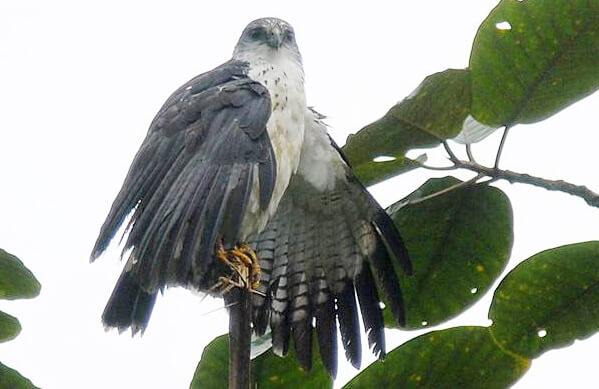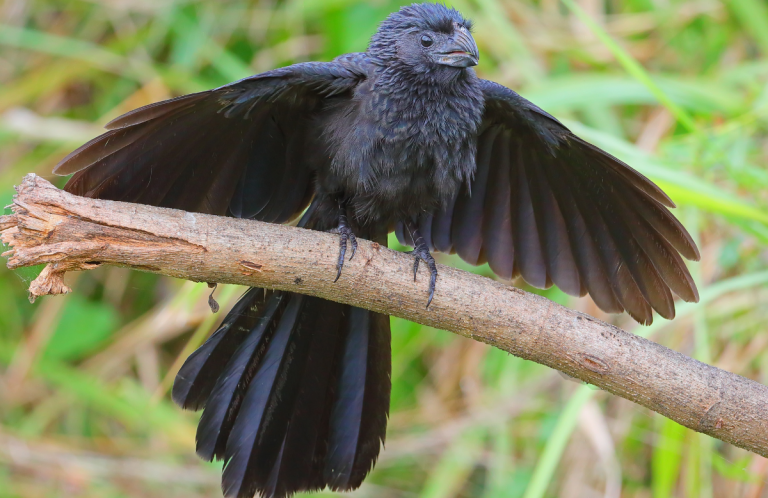 The reptile-loving Grey-backed Hawk is a medium-sized, black-and-white hawk found only in the forests of western Ecuador (including the ABC-supported Buenaventura Reserve) and adjacent northwestern Peru. Adult birds have blackish wings and grey heads and napes with white streaks. Specialists in forest-edge hunting, these birds often prey on snakes and lizards as well as frogs, rodents, and small birds as well as insects, earthworms, and crabs.
The reptile-loving Grey-backed Hawk is a medium-sized, black-and-white hawk found only in the forests of western Ecuador (including the ABC-supported Buenaventura Reserve) and adjacent northwestern Peru. Adult birds have blackish wings and grey heads and napes with white streaks. Specialists in forest-edge hunting, these birds often prey on snakes and lizards as well as frogs, rodents, and small birds as well as insects, earthworms, and crabs.
Grey-backed Hawk emits a loud, repeated shreeeyr in flight similar to that of White Hawk. (In fact it was once thought to be a subspecies.)
Habits of the Grey-backed Hawk
When at rest, Grey-backed Hawk is often found perched in the middle to upper story of the forest canopy.
Males and females are usually solitary, except when breeding. This resident species breeds year-round, re-using nest sites and building nests of branches lined with greenery.
One study found that Grey-backed Hawks often build nests in edge-forest areas located on steep hillsides near water. The female incubates a single bluish-white egg for approximately 36 days while the male hunts for the pair. Chicks fledge an average of 72 days after hatching.
Endangered in Ecuador
The largest concentrations of Grey-backed Hawk occur in Machalilla National Park and the Cerros de Amotape National Park in Ecuador. But habitat loss and fragmentation in these areas and throughout the bird's range have contributed to a rapid population decline.
Sign up for ABC's eNews to learn how you can help protect birds
More than 90 percent of western Ecuador has been cleared by logging, agricultural use, and other human-related activities. Machalilla National Park, for instance, has suffered serious disturbances from such activities as timber harvesting and hunting. Although Grey-backed Hawks are often seen feeding in patches of degraded habitat and forest edges, conservationists are concerned that some individual breeding pairs have become too isolated to support a viable population.
In many parts of the hawk's range, livestock grazing—particularly cattle and goats–has taken a toll on the forest understory, which likely makes it more difficult for the hawks to find prey. The birds are sometimes persecuted by humans who believe they are a threat to domestic animals such as chickens.
Beauty of Buenaventura
Private protected areas such as Buenaventura Reserve, run by ABC partner Fundación Jocotoco, are important strongholds for the hawk's remaining population and have a critical role to play in conservation efforts. Several breeding pairs have been sighted at Buenaventura, one of several private reserves where reforestation work is benefiting Grey-backed Hawk as well as many other species.
The Buenaventura Reserve features a lovely lodge and is a spectacular designation for birding. It promises plenty of hummingbird species as well as rarities like El Oro Parakeet and Club-winged Manakin. (Learn more on our Conservation Birding website.)
Double Your Impact!
With your help, we can scale up our work, evolving our strategies for endangered birds like Grey-backed Hawk. Thanks to generous ABC supporters, from now until June 30, a dollar-for-dollar challenge match is in effect. Make a gift today and your contribution will be doubled!
Donate to support ABC's conservation mission!



















































